This document presents an experimental study on the performance of eco-friendly refrigerant blends, specifically mixtures of R134a, R406A, and R600A as alternatives to the harmful refrigerant R-12. The results indicate that a 50:50 blend of R134a and R600A offers a coefficient of performance (COP) of 2.30, surpassing R-12's COP of 2.08. The research highlights the necessity for environmentally safe refrigerants in response to the Montreal Protocol and the ongoing phase-out of chlorofluorocarbons (CFCs).
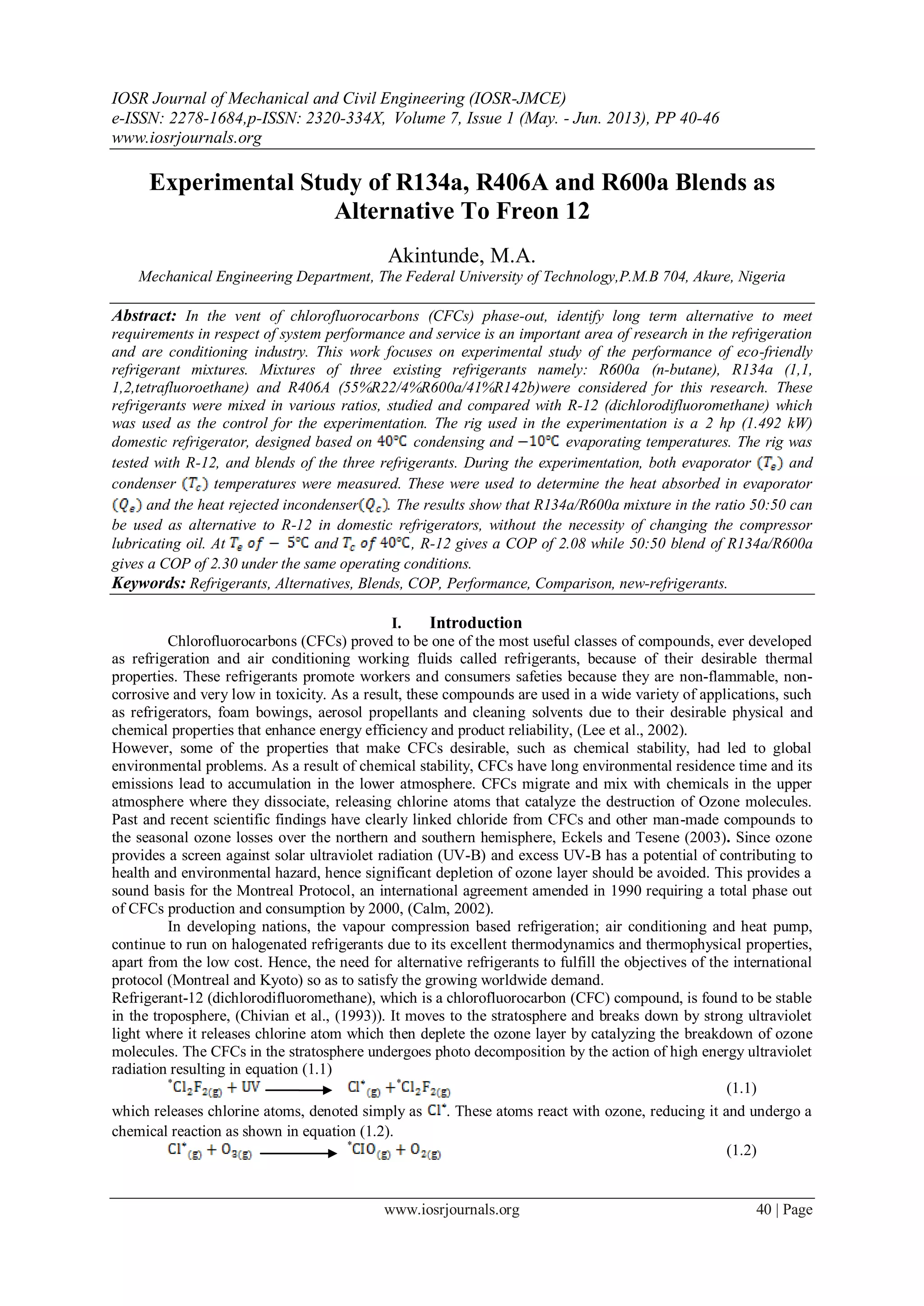

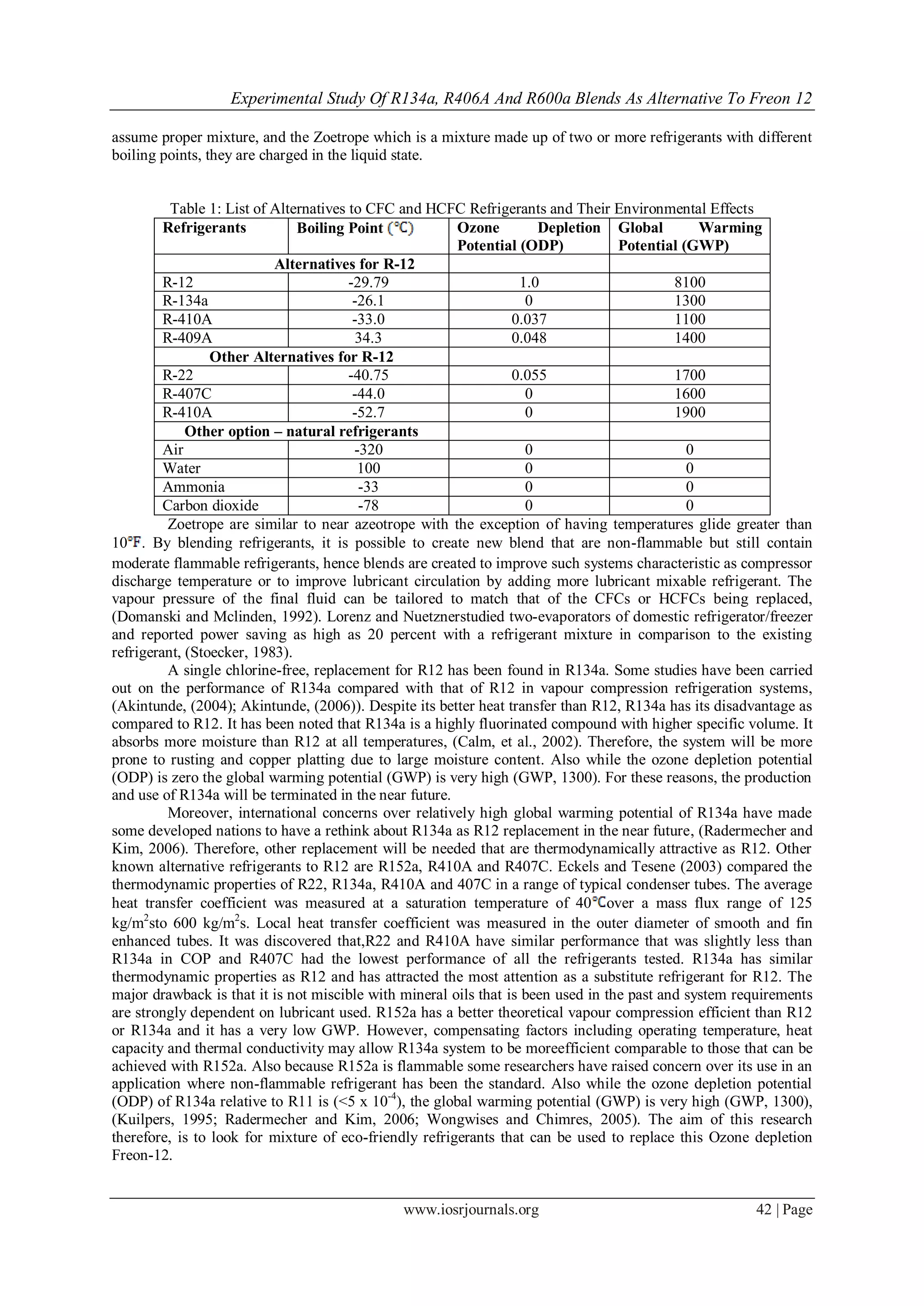
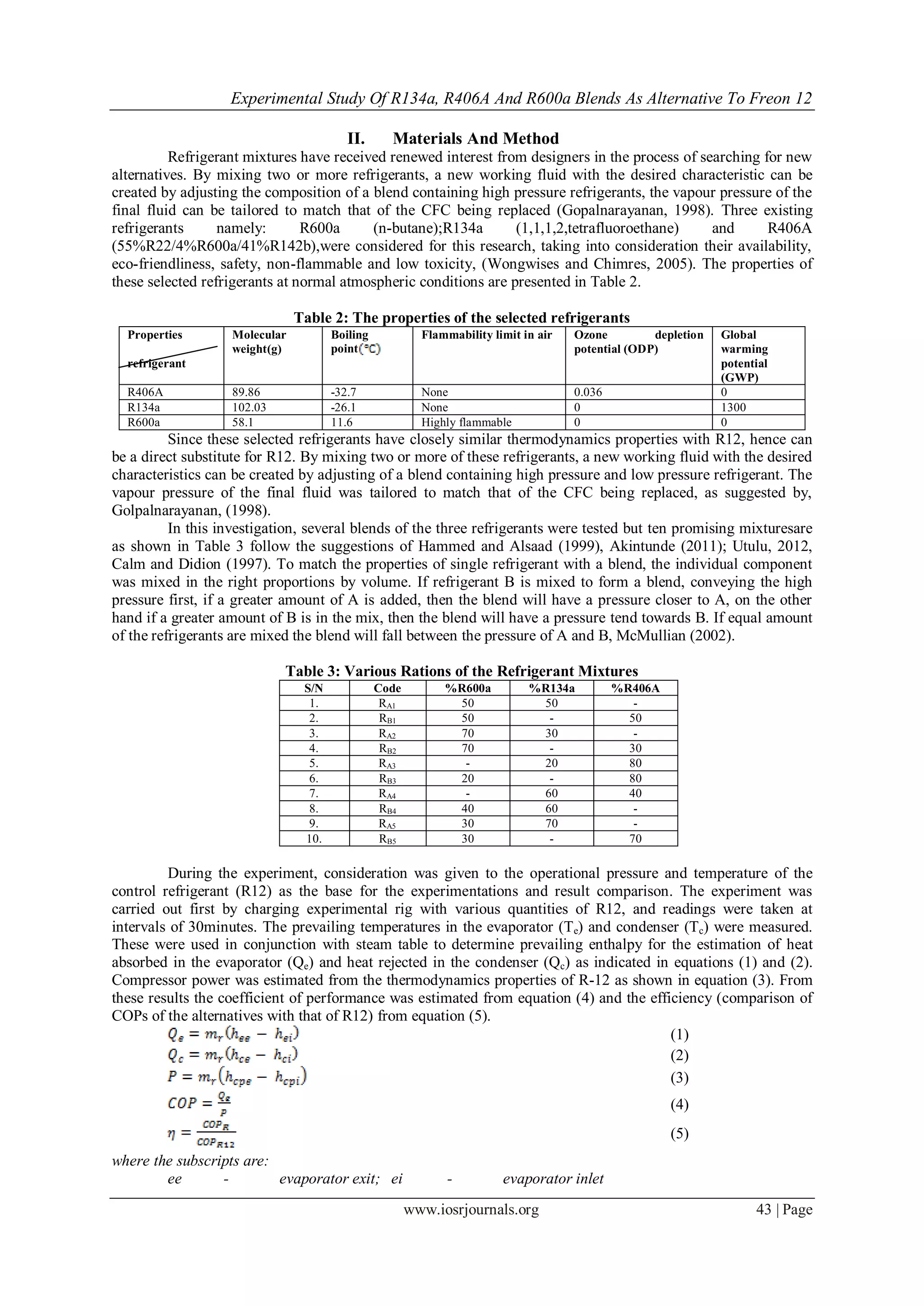
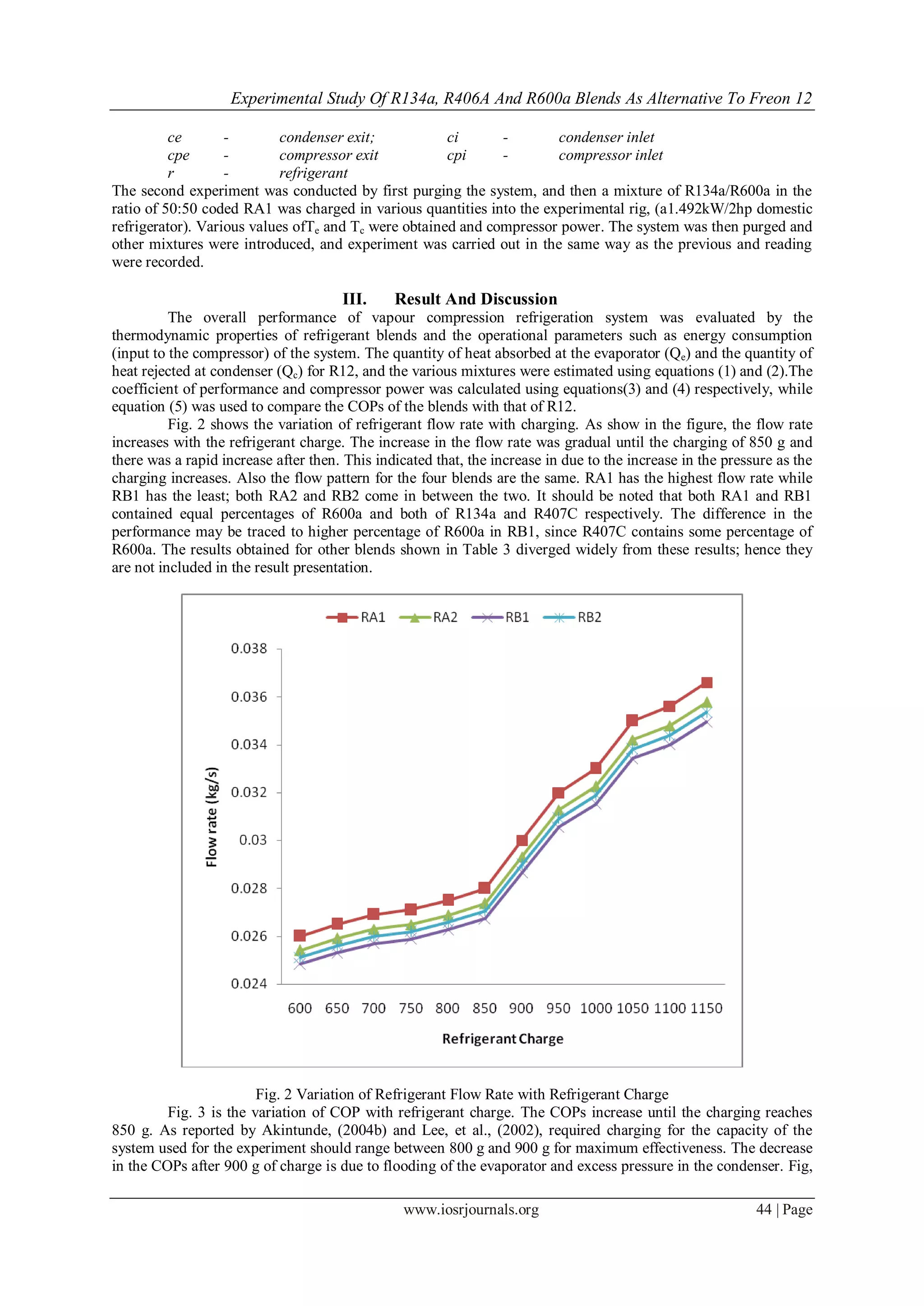
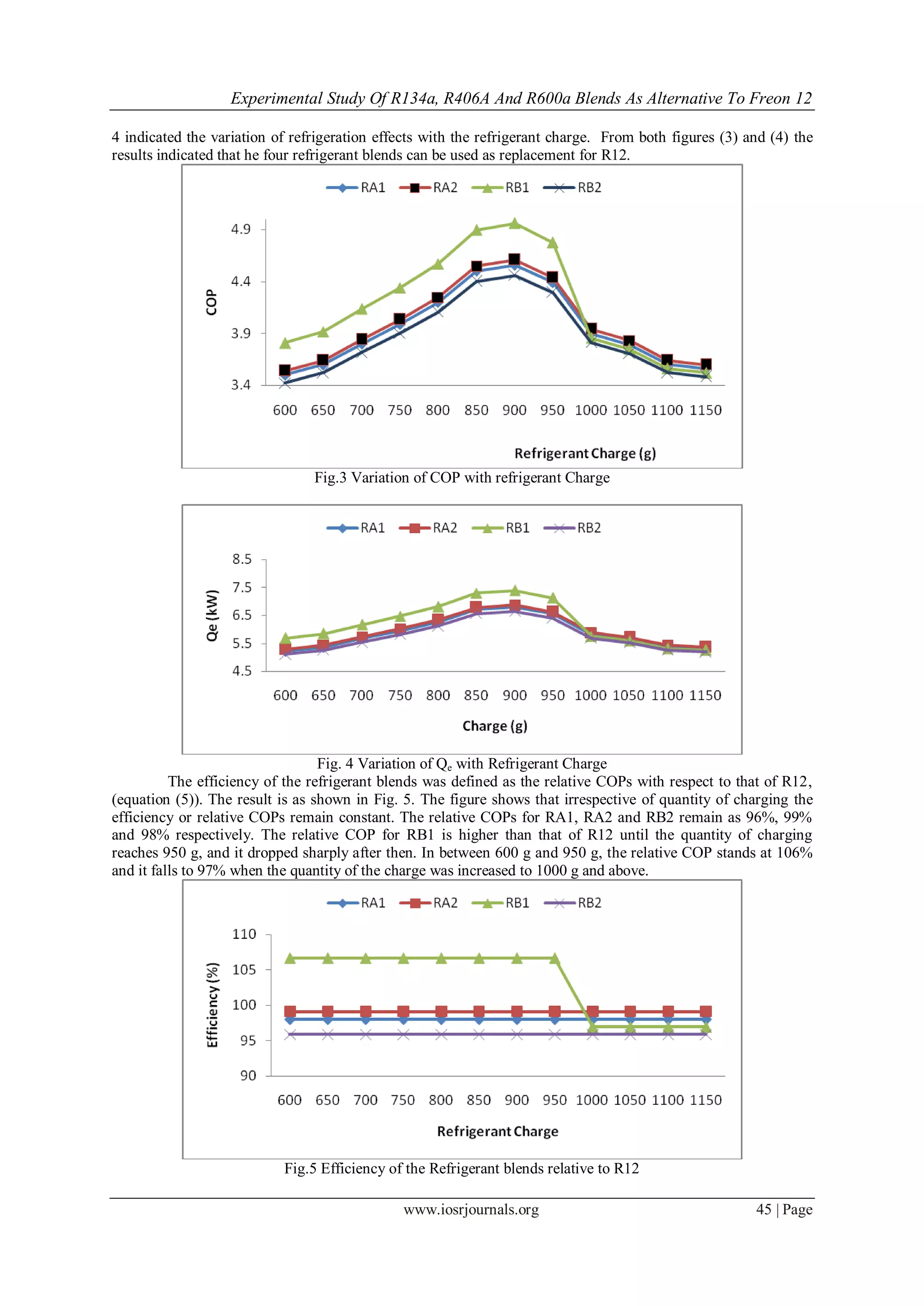
![Experimental Study Of R134a, R406A And R600a Blends As Alternative To Freon 12
www.iosrjournals.org 46 | Page
As shown in figures (2) to (5) RA1, RA2, RB1 and RB2 can be used as alternative to R12 provided the
charging quantity ranges between 600 g and 900g. Further works were done on the transport properties of the
refrigerant blends by Akintunde, (2013). From the results gotten by Akintunde (2013) and this present study,
the blends considered and reported on can be used as alternative to R12.
IV. Conclusion
This research focuses on refrigerant blends as alternatives to R12, one of the principal actors in ozone
depletion. In accordance with the set objectives, the experimented refrigerant mixtureswere obtained by
blending varying proportion of R600a, R134a and R406A.The refrigerant blends were experimented in an
existing refrigerator unit, which was designed to use R12 as its working fluid.RA2 which is the blend of
70%R134a/30%R406A was observed to have similar operating conditions asthat ofR12. The performance
observed, during experimentation, justified that compressors designed for R12 can be used for RA2, without
changing compressor lubricating oil. The obtained results of the refrigerant blends were then compared with that
R12. The overall assessment of the result favoured the use of RA1, RA2, RB1 and RB2 refrigerantsblends as
alternative to R12., but the performance was obtained from the use RA1 mixture in the system. The results show
that irrespective of quantity of charging the efficiency or relative COPs remain constant. The relative COPs for
RA1, RA2 and RB2 remain as 96%, 99% and 98% respectively. The relative COP for RB1 is higher than that of
R12 until the quantity of charging reaches 950 g, and it dropped sharply after then. In between 600 g and 950 g,
the relative COP stands at 106% and it falls to 97% when the quantity of the charge was increased to 1000 g and
above.
Reference
[1]. Akintude, M.A; Adegoke C.O; Fapetu, O.P (2004), “Experimental Investigation of the Performance of A Design Model for Vapour
Compression Refrigeration System”. West Indies Journal of Engineering. Vol. 28 No: 2, pp 80-87
[2]. Akintunde, M. A. (2004), Experimental Investigation of the Performance of R12 and R134a in Capillary Tubes for
Refrigeration Systems. Journal of Engineering Science and Technology, University of Ilorin. Vol. 4 No:1, pp 1 – 12.
[3]. Akintunde, M. A. (2004b) “Theoretical Design Model for Vapour Compression Refrigeration Systems”. –AMSE
Periodicals, France. Vol. 73 No: 5, pp 1 – 14.
[4]. Akintude, M.A. (2006). Experimental Investigation and Modeling solubility in R12 and R13a. Journal of Engineering and Applied
science, Vol 1 No 1 pp 14-22
[5]. Akintude, M.A. (2006). Validation of a Vapour Compression Refrigeration System Design Model. American Journal of scientific and
Industrial Research (AJSIR). Vol 2 No 4, pp 504-510.
[6]. Akintude, M.A. (2013)Experimental Investigation of Thermal Conductivity and Thermal Diffusivity of New Refrigerants
Blends.International Journal of Emerging Trends in Engineering and Applied Sciences (JETEAS). Vol. 4 No: 2, pp 328 – 332.
[7]. Bhatti, M.S. (1999). A historical Look at chlorofluorocarbon Refrigerant ASHRAE transaction, part 1.Pp 1186-12006.
[8]. Calm, J. M. (2002). Emission and environmental impacts from air-conditioning and refrigeration.International Journal of
Refrigeration. Vol. 25, No: 7, pp 293 – 305.
[9]. Calm, J.M and Didion, D.A. (1997). Trade- offs in refrigerants selections: Past, present and future. American Socierty of Heating
refrigerating and Air-conditioning Engineers (ASHRAE), Inc. Altanta (GA):pp 433-444
[10]. Chivian, A.E; McCally, M; Hu and Haines, A. (1993).Loss of stratospheric Ozone and health effect of increase ultra violent
radiation. The MIT press Cambridge.
[11]. Domanski, P.A and Mclinden, M.O (1992). A simplified Cycle Simulation model for the performance rating of Refrigerants and
Refrigerants Mixtures. International Journal of Refrigeration.Vol 115, No: 2 pp 81-88
[12]. Eckels, S.J and Tesene, B.A (2003). A Comparison of R22, R134a, R410A and R407C, Condensation Performance in Smooth and
Enhance Tubes: Part 1, Heat Transfer ASHIRAE Transaction, pp 428-441.
[13]. Gopalnarayanan S. (1998). Choosing the right refrigerant.Mechanical Engineering, published by the American society of Mechanical
Engineer (ASME).Vol 11120 No 11.Pp 1181- 1189
[14]. Hwang, Y. Ohadi; M and Radermacher, R (1998).Natural Refrigerants. Mechanical Engineering published by American society of
Mechanical Engineers (ASME). Vol 1120 No 10, pp 96-99
[15]. Kuijper, L. (1995). Hydrocarbon and the Montrel Protocol Mechanism. Proceedings of International CFC and Halon attentive
conference, Washington D.C., October 23-25: pp 167-173.
[16]. Lee, J. H.; Bae, S. W. Bang, K. H.; and Kim, M. H. (2002).Experimental and numerical research on condenser performance for R-22
and R- 407C refrigerants.International Journal of Refrigeration. Vol. 25, No: 8, pp 372 – 382.
[17]. McMullian, T.J (2002). Refrigerator and the environment issues and strategies for the future international Journal of refrigeration
Vol. 25 No 5; pp 89-99
[18]. Radermacher, R and Kim, K (2006).Domestic refrigeration Recent Development. International Journal of Refrigeration, Vol 119 pp
58-62
[19]. Stoecker, W.F. (1983). Improving the Energy Effectiveness of demerits refrigerator by the application of refrigerant mixtures cont-
830568-1, in; proceeding of the international technical application conference Indiana, pp 3-9
[20]. Wongwises, S. and Chimres, N, (2005). Experimental study of hydrocarbon mixtures to replus HCF134a in a Domestic refrigerator,
Energy Conservation and Management, Vol. 46 pp 85-100.](https://image.slidesharecdn.com/g0714046-150115230720-conversion-gate01/75/Experimental-Study-of-R134a-R406A-and-R600a-Blends-as-Alternative-To-Freon-12-7-2048.jpg)